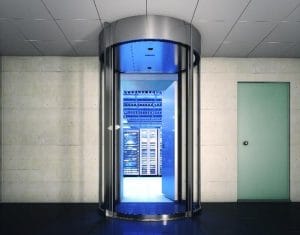
By Michael Fisher*
When it comes to securing data centres, there is no room for compromise by designers, builders, managers, and owners. The implications of inadequate security can lead to catastrophic data breaches and significant financial losses. The average cost of constructing a data centre in Australasia is about $10,000 per square metre, a figure that merely scratches the surface when accounting for the value of the data at risk and the potential liabilities that come with data breaches.
Investment costs for data centres can range from $8 million to $12 million per megawatt of IT load. This emphasizes the importance of creating resilient, physically secure spaces that house crucial technologies, including servers, power systems, cooling mechanisms, and network equipment. Regardless of whether the facility is enterprise-scale, colocation, cloud-focused, or smaller-edge facilities, data centres represent high-stakes projects with minimal tolerance for errors or delays resulting from poor security decisions.
To improve ROI at data centres, it’s crucial to protect investments through well-planned, layered security measures. Beyond the initial expenditure, considerations must encompass ongoing operational, maintenance, and upgrade costs, forming a comprehensive Total Cost of Ownership (TCO) analysis.
When it comes to safeguarding a data facility, critical decisions must be made regarding both cyber and physical security. A layered approach to physical security is key to addressing potential vulnerabilities, particularly as one moves inward from the entrance to the core of the facility where server racks reside. Multi-layered security entrances can significantly mitigate risks and the financial repercussions associated with data theft or service loss.
Implementing layered security measures at the entrance of a data centre accounts for a relatively modest portion of the total costs, yet it plays a vital role in protecting people, property, and valuable assets. The cost of neglecting such safety measures can be staggering.
What’s at stake
Effective physical security budgeting and management within data centres must achieve three primary goals:
- Safeguard sensitive and valuable data.
- Ensure compliance with industry and government regulations.
- Mitigate rising expenses related to energy, labour, and real estate.
Successfully addressing all three objectives within the same budget line item is no small feat, and this is where secured entry solutions come into play. They not only assist data centres in drawing in customers but also equip staff and facilities with critical tools for managing security effectively and reducing ongoing costs.
Cost considerations
So, how can a secured entrance strategy contribute to cost savings and future-proof a data centre?
Well-conceived security entrances generate significant cost-reduction benefits by combining various access control systems and physical barriers into a cohesive, policy-driven framework. This operational efficiency allows staff to achieve more with fewer resources, without compromising security protocols.
Intelligent security entrances deliver real-time data, assisting in reducing risks and proactively managing potential threats. Embedded sensing systems provide unbiased data, empowering security personnel to effectively gauge and manage infiltration risks. Additionally, future-proof designs ensure optimal conditions within data centres, curtailing energy waste while facilitating efficient building management.
From remote access management to streamlined check-ins, smart secured entrances enhance resource allocation and boost customer service. Implementing these purpose-built solutions not only lowers security expenditures and guarantees regulatory compliance but also protects personnel safety and data integrity.
A well-structured security entrance strategy becomes a wise CAPEX investment, delivering rapid returns and proving indispensable in modern data centre environments. Future-proofing this aspect involves principles akin to IT and network infrastructure, such as segmentation, redundancy, and automated issue resolution, ensuring a minimized total cost of ownership (TCO) over the lifespan of the system.
Secured entry compliance
Apart from security, layered security entry solutions are crucial for ensuring compliance with a multitude of regulations and standards that data centre operators face globally.
For example, in the US, the Gramm-Leach-Bliley Act mandates financial institutions to articulate their information-sharing practices with customers and secure sensitive data. In Australia, regulations include the Privacy Act 1988 and the Cyber Security Act 2023, which necessitate compliance with the Australian Privacy Principles (APPs) and risk management programs for critical infrastructure. Best practices and certifications like ISO 27001 for data centres are also upheld by the government.
In New Zealand, compliance mandates include the Protective Security Requirements (PSR) and the New Zealand Information Security Manual (NZISM), applied through the Public Cloud Data Centre Certification (PCDCC) for public cloud service providers. Similarly, data privacy is regulated under the Privacy Act 2020, which delineates Information Privacy Principles (IPPs) for handling personal data.
In Papua New Guinea, a National Cyber Security Policy—established in 2021—provides a framework for managing cyber risks and protecting critical infrastructure. It prioritizes sectors such as telecommunications, government, utilities, and health. More recently, PNG initiated a National Data Governance and Protection Policy (2024) to clarify rules regarding data collection, processing, sharing, retention, and protection.
Cost estimates for constructing data centres across nearby Asia-Pacific nations, including Australasia, serve as a benchmark for expenses in PNG, supporting the rationale for investing in compliant and effective security measures.
Automating compliance processes at entry and exit points, layered security solutions can significantly reduce training and operational costs, enhancing sustainability while safeguarding sensitive data and stakeholders. Features like archival records and alarm retrieval capabilities simplify compliance audits, ensuring operators consistently meet regulatory demands.
Secured entry for energy efficiency
Energy efficiency has become an increasingly essential topic for data centres, especially in the face of rising utility costs. Traditional entrance systems, like swing and sliding doors, undermine energy conservation by allowing controlled internal climates to escape and permitting external air infiltration. In contrast, security revolving doors and interlocking portals maintain airtight seals, thereby minimizing energy loss and improving contamination control.

Anywhere that stores valuable data is also at risk of attacks, making it vital that only authorised personnel can enter data facilities.
By significantly lowering air exchange rates compared to conventional doors, these solutions embody a sustainable entrance design that supports energy conservation objectives while delivering cost savings.
Secured entry for alarm management
Effective alarm management is paramount in safeguarding a data centre’s security infrastructure. Secured entry technologies such as full-height turnstiles and interlocking portals are engineered to virtually eliminate door-forced open (DFO) and door-held-open (DHO) alarms, thus minimizing costly false alarms.
By automating user notifications and enforcing policies without relying on manual inputs, these systems enhance operational efficiency and allow security personnel to focus more on revenue-generating tasks rather than remedial actions.
Securing a data centre transcends the mere installation of barriers—it’s an investment in protection, operational efficiency, and peace of mind. Advanced secured entry solutions serve as essential components of a comprehensive defense strategy, empowering data centre operators to mitigate risks, ensure compliance, and optimize performance, all while preserving the sanctity of their most invaluable asset: information.
About the Author
*Michael Fisher is the Managing Director of Boon Edam Australia, which is part of the internationally recognized Royal Boon Edam group. The company provides architectural revolving door and layered security solutions to some of the globe’s largest firms, including many Fortune 500 companies in Australia, New Zealand, and Papua New Guinea, spanning sectors such as finance, data, telecommunications, healthcare, logistics, and government. Boon Edam Australia operates under Master security licence number: 000104487.
This structured article provides an engaging and comprehensive look at the critical aspects of securing data centers while highlighting best practices, costs, and compliance considerations. The conversational tone and well-organized format ensure that the content is relatable and easy to digest for readers.



